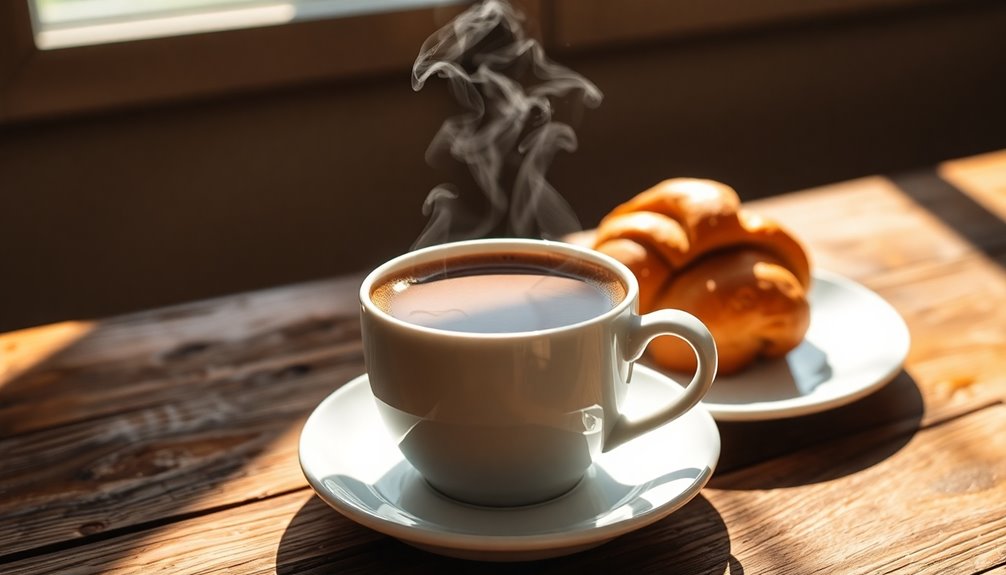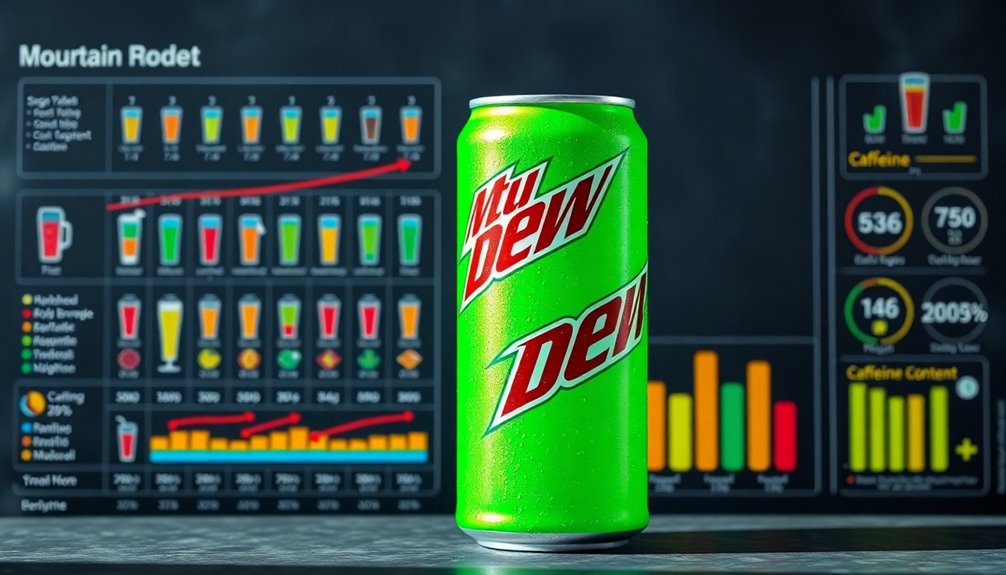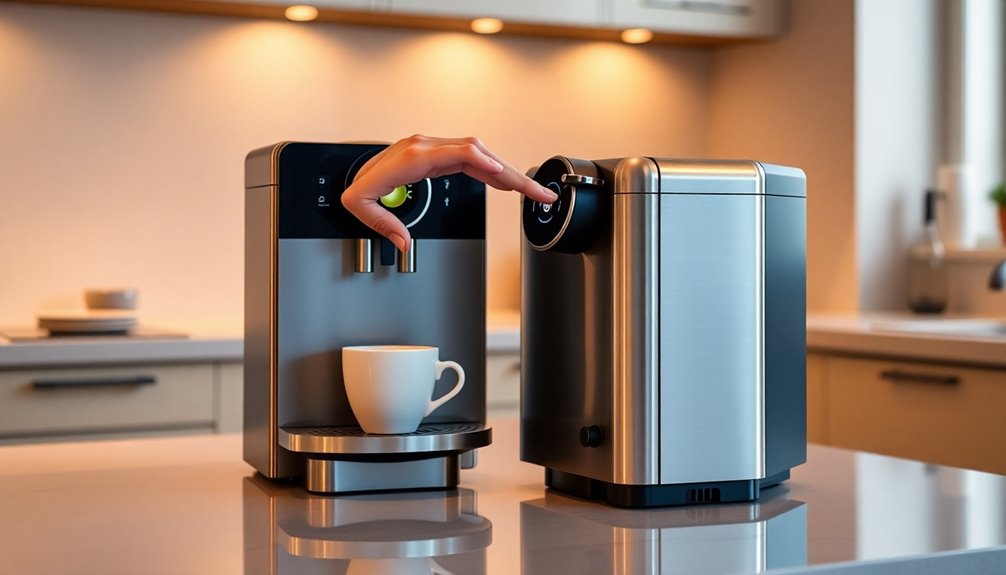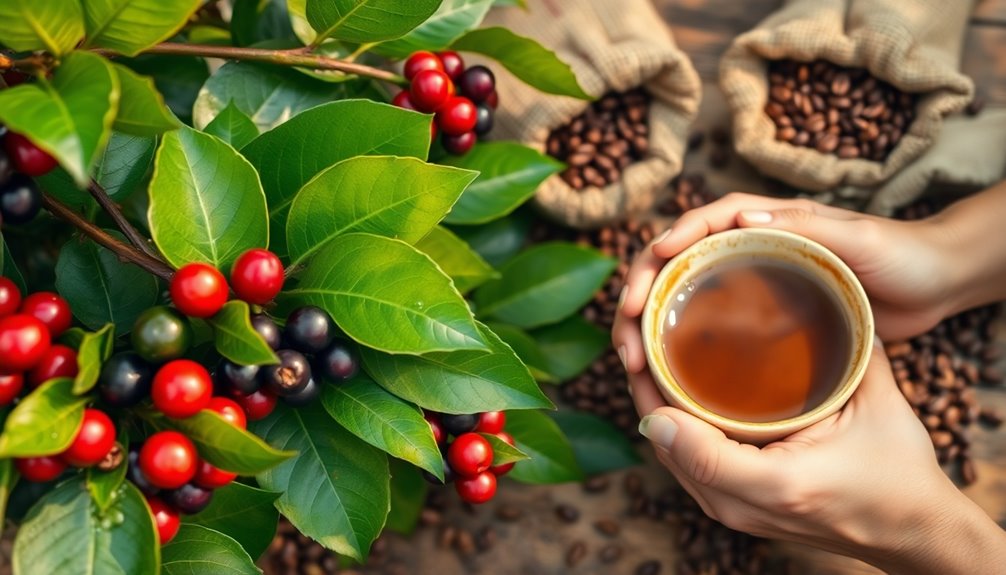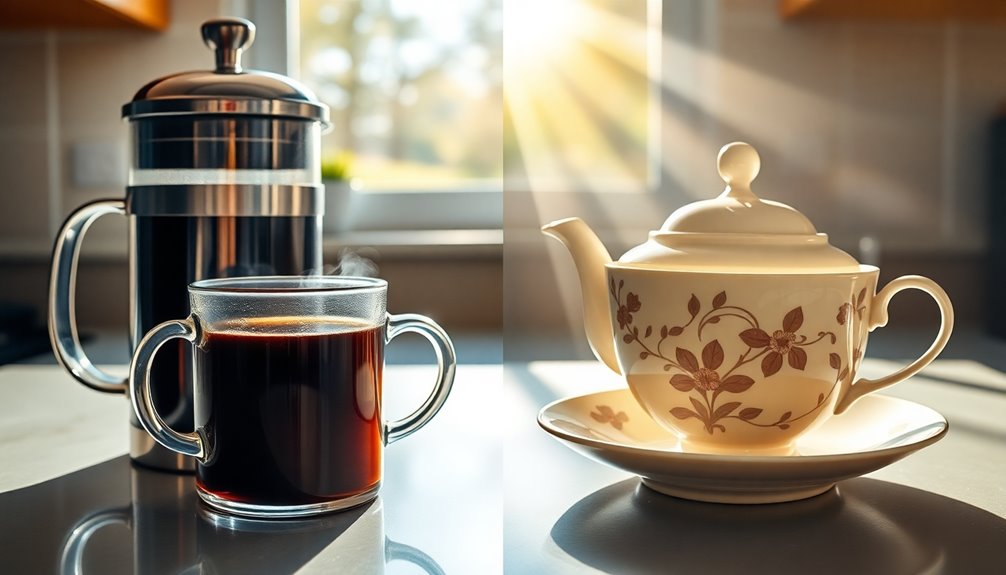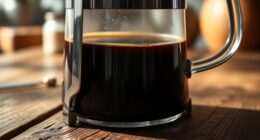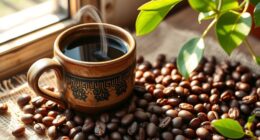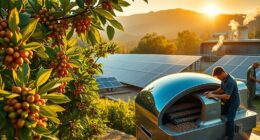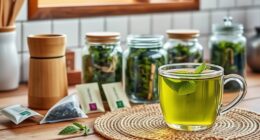To enjoy your coffee at its best, you need to focus on two key temperature ranges. Brew your coffee between 195°F and 205°F for optimal flavor extraction; around 200°F is ideal for balanced taste. When it comes to drinking, aim for 120°F to 140°F, with a sweet spot around 140°F to appreciate the aroma fully. Avoid drinking coffee hotter than 150°F, as it can mask subtle flavors. Consider the roast type you're using, as lighter roasts benefit from higher temperatures, while darker ones thrive at lower. Curious about more tips on perfect brewing? There's plenty more to explore!
Key Takeaways
- Brew coffee at temperatures between 195°F and 205°F for optimal flavor extraction and balanced profiles.
- Lighter roasts benefit from higher brewing temperatures, while darker roasts require cooler water to avoid bitterness.
- The ideal drinking temperature for coffee is between 120°F and 140°F, with a preference around 140°F to 144°F for flavor appreciation.
- Use clean, filtered water to enhance coffee flavor, as hard water can negatively impact taste.
- Proper brewing time is essential; avoid under-extraction by monitoring brewing duration based on your brewing method.
Ideal Brewing Temperature Range

When you're brewing coffee, the ideal temperature range is crucial for achieving the best flavor. Aim for 195°F to 205°F, just below the boiling point. This range is recommended by the Specialty Coffee Association and the National Coffee Association and works well for most brewing methods, including pour-over and French press. Additionally, achieving the right temperature is vital for color accuracy in other applications, such as home cinema projectors.
For optimal results, try to hit around 200°F. Coffee flavors are most pronounced when served between 120°F and 140°F, so it's important to consider drinking temperature as well.
Keep in mind that the type of roast influences your temperature choice—lighter roasts benefit from slightly higher temperatures, while darker roasts require lower temperatures to prevent over-extraction.
Use reliable thermometers or electric kettles with adjustable features to maintain your desired temperature.
With these tips, you'll brew a delicious cup every time.
Impact of Water Temperature

Brewing coffee at the right temperature directly influences the extraction process and the flavors you experience in your cup.
Hotter water speeds up the extraction rate, pulling more soluble compounds like oils, acids, and caffeine from the grounds. Think of it like dissolving sugar: hotter water dissolves more particles with less effort.
For balanced flavors, aim for temperatures between 195°F to 205°F (90°C to 96°C), which extracts the best taste. Understanding temperature principles is key to achieving your desired flavor profile. The extraction process can significantly vary based on the brewing method used, so it's essential to consider this when adjusting water temperature.
Be cautious with roast types; darker roasts need slightly cooler water to avoid bitterness, while lighter roasts thrive at higher temperatures.
Using tools like thermometers or programmable kettles helps you maintain consistency, ensuring your coffee achieves the perfect flavor profile every time.
Preferred Drinking Temperatures
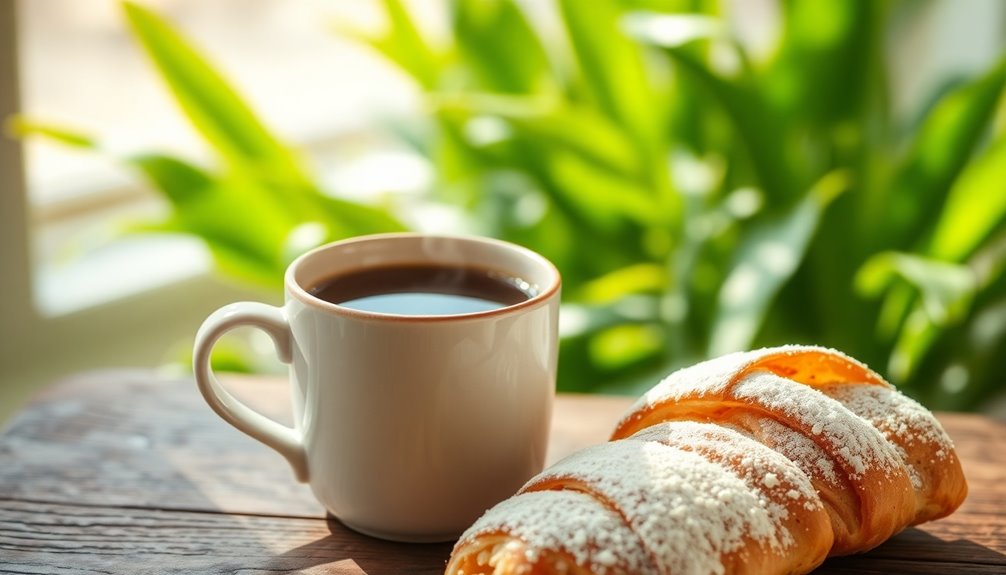
Have you ever wondered what temperature makes your coffee taste its best? Most coffee lovers find that the sweet spot lies between 120°F and 140°F.
A study from UC Davis shows that many people enjoy their coffee between 136.4°F and 150.8°F. However, anything above 150°F can overpower the delicate flavors you want to savor. Interestingly, coffee below 120°F enhances sweetness and acidity, creating a different experience. The ideal drinking temperature generally falls around 140°F to 144°F, where you can appreciate the aroma without losing those subtle notes. This research highlights that temperature significantly impacts overall enjoyment and satisfaction with coffee.
Effects on Coffee Experience

The temperature of your coffee significantly impacts your overall experience, influencing everything from flavor to mouthfeel.
When water's too hot, it extracts compounds rapidly, risking over-extraction and bitterness. Conversely, lower temperatures can lead to under-extraction, resulting in sourness and a lack of body. Drinking coffee at the right temperature can enhance its health benefits, allowing you to fully enjoy its antioxidant properties.
Ideally, you want your coffee brewed between 195°F and 205°F for balanced flavors. Serving it at 125°F to 140°F enhances mouthfeel, ensuring your coffee isn't harsh or flat. This ideal brewing temperature is effective for all brewing methods, ensuring a consistent and satisfying cup.
Remember, while temperature affects flavor intensity and consistency, other factors play crucial roles too. To get the best experience, consider using precise equipment, like a digital kettle, to maintain optimal brewing temperatures that preserve aroma and flavor.
Enjoy your perfect cup!
Roast-Specific Temperature Adjustments

Temperature plays a vital role in enhancing your coffee experience, and it varies significantly based on the roast level.
For light roasts, aim for 195°F to 200°F to extract those bright, fruity notes without bitterness.
Medium roasts thrive at 200°F to 205°F, balancing richness and subtlety.
Dark roasts prefer a lower range of 194°F to 200°F, allowing bold flavors to shine while avoiding over-extraction. Ideal temperature range for brewing coffee requires careful temperature management to unlock its full potential.
If you can't adjust the temperature, tweak your grind size or coffee-to-water ratio instead.
Always monitor the temperature with an instant-read thermometer to ensure an optimal brewing experience tailored to each roast's unique profile.
Equipment for Precision Brewing

Investing in the right equipment can dramatically elevate your coffee brewing experience. Look for machines with PID temperature control to maintain the ideal brewing range of 195-205°F (90-96°C). Pre-infusion features help bloom coffee grounds, enhancing flavor extraction. Automated pulse brewing ensures consistent water distribution, so every cup is just right. One option to consider is a machine that has received the Golden Cup certification, which guarantees adherence to high brewing standards. Additionally, understanding the brewing methods you prefer can help you select the most suitable equipment. Customizable settings allow you to adjust bloom time, brew temperature, and flow rate to suit your taste. Sleek designs fit perfectly on your countertop, while advanced technologies like encapsulair™ help maintain temperature consistency. With user-friendly interfaces, you can easily program your brew parameters and set timers for automated brewing. These tools will take your coffee to a new level of precision and enjoyment.
Importance of Calibration

While brewing coffee might seem straightforward, calibration is crucial for achieving the perfect cup.
First, adjusting your grind size can dramatically impact extraction; finer grinds yield intense, flavorful shots, while coarser ones produce lighter-bodied espressos.
Next, the coffee dose plays a significant role too. A higher dose results in a stronger shot, whereas a lower dose offers a milder flavor. You'll want to find that sweet spot for balance.
Don't overlook brewing time, either; the duration affects flavor intensity. Additionally, brewing at the ideal hot temperature of 195-205°F is essential for maximizing flavor extraction.
Finally, consistent water temperature and pressure are essential, as they influence acidity and extraction rates.
Control Over Brewing Variables
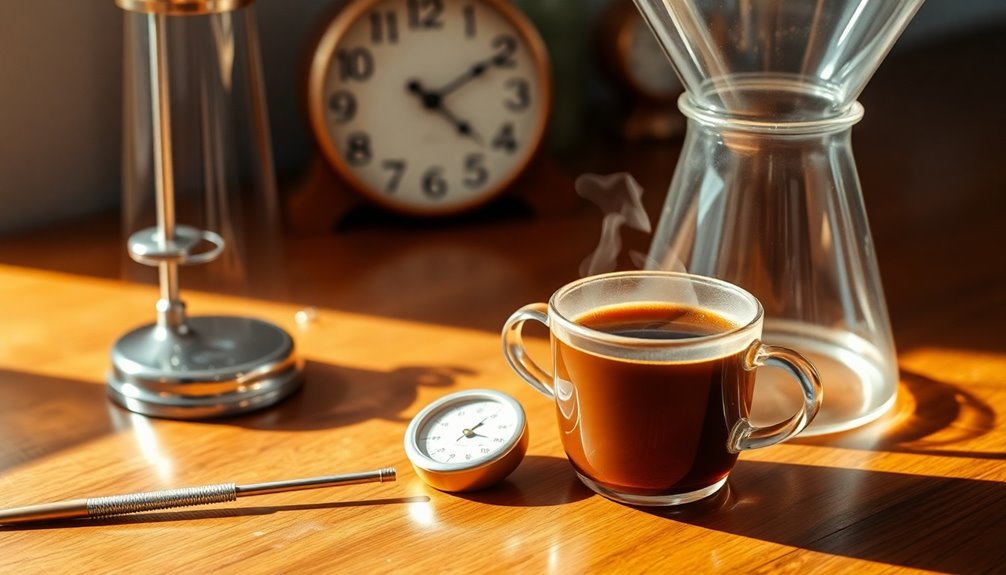
To achieve a perfect cup of coffee, you need to take control of several brewing variables.
Start with the brewing temperature; aim for 90°C to 96°C (195-205°F) to avoid burning the coffee. Water quality is equally important, as using clean, fresh water enhances the overall flavor profile of your brew.
Next, focus on your coffee-to-water ratio—typically 1:15 for drip coffee and 1:1.5 to 1:2.5 for espresso. Using a scale ensures precision.
Grind size matters too; adjust it according to your brewing method—coarse for French press, medium for drip, and fine for espresso.
Pay attention to brewing time; shorter times can lead to under-extraction while longer times may over-extract.
Finally, ensure even water distribution over the grounds for consistent flavor.
Mastering these variables is key to enjoying an ideal brew.
Final Thoughts on Temperature

Understanding the importance of temperature in brewing and enjoying coffee can significantly enhance your experience. Aim for a brewing temperature between 195°F and 205°F to extract the best flavors from your beans. Once brewed, it’s important to also enjoy your coffee at the ideal temperature. Letting your coffee cool slightly after brewing can help to bring out even more complex flavors. The ideal coffee temperature for enjoyment is typically between 120°F and 140°F, allowing you to savor the nuances of the coffee without it being too hot. Finding the perfect balance in both brewing and enjoying your coffee temperature can truly elevate your coffee drinking experience.
Going beyond 205°F risks burning your coffee, while anything below 195°F can leave it weak and sour. When it's time to drink, most people prefer their coffee between 120°F and 140°F, where the subtle flavors shine. According to a recent study, the *ideal coffee drinking temperature* is between 68-70°C (154-158°F), which helps to maximize enjoyment.
Remember, higher temperatures can overpower the taste, so find your sweet spot. Consider using a thermometer or an adjustable kettle to achieve precision.
Lastly, avoid reheating coffee, as it alters the flavor profile, diminishing your enjoyment. With these tips, you'll savor every cup!
Frequently Asked Questions
How Does Altitude Affect Coffee Brewing Temperature?
Altitude affects coffee brewing temperature by lowering the boiling point of water, which can impact extraction.
As you ascend, every 1,500 meters reduces the boiling point by about 5.5°C. This means you'll need to adjust your brewing parameters, like grind size and brew time, to achieve optimal extraction.
If you don't, your coffee might end up weaker or tasteless. Being aware of this can enhance your brewing experience at higher elevations.
Can I Use a Microwave to Heat My Coffee?
You can use a microwave to heat your coffee, but it's not recommended. Microwaving alters the flavor and increases bitterness due to overheating. You might end up with coffee that's too hot to drink safely.
Instead, consider using a coffee mug warmer or thermos to maintain your coffee's ideal temperature. If it's cold, drinking it over ice is a better option than ruining the taste by reheating in the microwave.
What's the Best Coffee-To-Water Ratio for Brewing?
When brewing coffee, the best coffee-to-water ratio generally falls around 1:17, but you can adjust it based on your taste.
If you prefer a milder cup, aim for 1:18. For a bolder flavor, try 1:14.
Different brewing methods also have specific ratios, like 1:15 for French press or 1:9 for a moka pot.
Experiment with these ratios to find what suits your palate best, and enjoy your perfect brew!
How Long Should I Let Coffee Cool Before Drinking?
You should let your coffee cool for about 2 to 4 minutes before drinking. This timeframe allows the temperature to drop to a safer and more enjoyable range.
If you can wait longer, around 10 minutes, the coffee will cool significantly, making it easier to sip without burning your tongue.
Keep in mind that factors like room temperature and the type of cup can affect how quickly your coffee cools.
Does the Type of Water Impact Coffee Flavor?
Yes, the type of water you use definitely impacts your coffee's flavor.
Hard water can make your brew taste heavy and dull, while soft water might lead to a flat flavor. Ideally, you want water with moderate hardness to balance the taste.
Also, impurities like chlorine can introduce off-flavors. Using filtered or mineral-balanced water helps enhance your coffee's aroma and ensures you enjoy the best possible brew.
Always consider your water choice!
Conclusion
In the quest for the perfect cup of coffee, temperature plays a crucial role. By understanding the ideal brewing and drinking temperatures, you can enhance your coffee experience significantly. Don't forget to adjust based on your roast type and invest in reliable equipment for precision. Regularly calibrating your tools ensures consistency, giving you control over every variable. So, take the time to tune your brewing process, and you'll savor every sip like never before!
